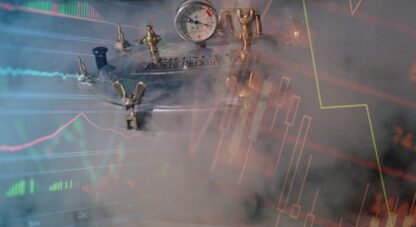Bad + Worse = Now
I certainly don’t find myself quoting Vladimir Lenin very often, but his observation that “there are weeks where decades happen” was increasingly on my mind as this week progressed. Major macro developments, Federal Reserve headlines, geopolitics, and consequential cross-asset market moves and volatility all conspired to make this week a memorable and impactful one. Overall, the gears of a major paradigm shift and market phase change were in motion as important developments rippled their way through the market system. “Buckle-up, brace yourself, and enjoy the show” sounds like wisdom at this juncture as markets promise to be anything but boring while existing dynamics play out.
The bombshell news of the week exploded on Thursday when the US Bureau of Labor Statistics reported another Consumer Price Index (CPI) stunner. On a monthly basis, headline CPI consumer prices jumped 0.65% while core CPI, excluding volatile food and energy, increased by 0.58% in January. The results outpaced analysts’ expectations for a 0.4% headline number and 0.5% core increase. On an annual basis, headline consumer prices increased to 7.5% from 7% last month, while core CPI has now reached 6% Y/Y from 5.5% last month. On both a headline and core basis, CPI inflation is now running at a fresh 40-year high. You would need Marty McFly’s DeLorean for a trip back to 1982 to see anything like the inflationary environment we now have on our hands.
The heat map below reveals a powerful and relentless inflation trend that is rapidly accelerating in an incredibly uncomfortable direction—uncomfortable for the consumer, uncomfortable for the Fed, and increasingly uncomfortable for markets. CPI has now come in hotter than Wall Street expectations in nine of the last 11 months. Rather than being “transitory” for the last year, inflation has been a runaway train now officially cranking the dial at a blistering 7.5% pace. Amazingly, at present, the Fed is still injecting liquidity into markets and the Fed funds rate remains at the 0% to 0.25% lower bound. The Fed is still accommodative and still stimulating. It is “hysterically” behind the curve.
![]()
Within the headline reading, the extremely consumer sensitive items of both food and energy came in with strong price increases. Food price increases accelerated at a 0.9% clip from 0.5% in December. Energy prices matched December’s large advance and came in with another 0.9% jump.
Beyond food and energy, the price increases across goods and services were significant and broad-based. Within the goods category, household furnishings & supplies, apparel, used cars, recreation commodities, and medical goods were all particularly strong. The only area of relative softness came from flat M/M prices for new cars. Unfortunately for consumers, however, plenty of price-hike damage was already done in new autos-land throughout 2021.
On the services side, it was a bad month to get sick. Health insurance, medical care services, and hospital services all posted robust price hikes. Notable price increases also emerged in airfares, transportation services, motor vehicle insurance, recreation services, other personal services, and water/sewer/trash services.
Combined, owners equivalent rent (OER) and rent of primary residence make up the shelter component of CPI. Shelter represents the largest contribution to CPI at just over 31%. OER posted another strong month of price increases, up 0.42%, while rent of primary residence reported its strongest monthly price jump since 1992 with a 0.54% advance.
Rents tend to be very sensitive to the labor market and wages. Currently, we have an extremely tight labor market in place. The number of open jobs that companies need to fill far outstrips the number of available unemployed workers. To make matters worse, the labor market is dealing with a historic quit rate. As a result, the bargaining power pendulum is swinging firmly toward labor for the first time in decades. The only immediate option for a corporate response to unfilled but needed positions is to raise wages and increase benefits. Unfortunately, after spending more for this labor, corporations have to cover those increased expenses by turning right around and raising the price for their own offered goods or services. This dynamic is the dreaded wage-price spiral, and we’ve got one on our hands now. This wage-price spiral will likely underpin a continued upward trajectory of rising rents, and the shelter component of CPI may consequently continue to heat up in the coming months. Taken together, wages, energy, food, and rent appear poised to maintain a buoyant pressure on prices for the foreseeable future.
The hot CPI inflation number significantly raised the prospects for a more aggressive Federal Reserve, and pushed stocks sharply lower and bond yields sharply higher. The 10-Year Treasury yield rose above 2.00% for the first time since the middle of 2019 before retracing on Friday. Simultaneously, a sharp selloff in stocks developed that continued right into Friday’s closing bell.
In response to the CPI print and a Federal Reserve that has downplayed the significance of the inflation scourge every step of the way, Bank of America said, “for the Fed, this report provides another wake-up call. Inflation is here and it continues to make its presence known everywhere.” A slightly different take, my own, is that we’re about five cups of coffee into the “wake-up call,” and this week CPI pulled out the smelling salts.
“This inflation data today came like a punch in the stomach for Jay Powell and his colleagues,” said Nathan Sheets, global chief economist of Citi Research. Referring to Powell and Fed policy makers on CNBC, Sheets added that, “their narrative is that as the year progresses, we should see inflation start to abate and to come on down… There was not even a hint of that in the January data.”
On Thursday, following the CPI shocker, in what was more smelling salts than arabica beans, St. Louis Fed president James Bullard chimed in on the unfolding monetary policy debate. In an interview with Bloomberg News, Bullard, who is a voting member on the Federal Open Market Committee (FOMC) this year, said “I’d like to see 100 basis points in the bag by July.”
Bullard also threw his support behind the first 50-basis point interest rate hike since May of 2000, but wasn’t sure whether a 50 bp increase would be appropriate in March or at a subsequent meeting. The St. Louis Fed-head said he would defer to Fed Chair Jerome Powell on that decision. Bullard now favors a plan that would spread the rate increases over three meetings, shrink the Fed’s balance sheet starting in the second quarter, and then, at that point, decide on the path of rates in the second half based on updated data.
Mr. Bullard said, “I was already more hawkish, but I have pulled up dramatically what I think the committee should do.” The St. Louis Fed chief then proceeded to blow the hawkish trumpet even louder. “There was a time when the committee would have reacted to something like this (by) having a meeting right now and doing 25 basis points right now,” Bullard said. He went on to say that, in his opinion, the Fed should be nimble and once again consider “that kind of thing.”
This was a very interesting comment. It raised the possibility that the Fed could, at any time, make an impromptu move to raise rates in between scheduled meetings, without the prior telegraphing the market has become accustomed to. His comment seemed intent on introducing uncertainty into market expectations after years of apparent Fed efforts to remove market uncertainty as much as possible. For now, he assured that policymakers are focused on the March 15-16 meeting for policy moves, and have committed to finishing asset purchases before kicking off rate increases. Nevertheless, his comments seemed to be a shot across the bow of market complacency toward a predictable Fed.
In interviews this week with CNBC and Bloomberg, economist and chief economic advisor at Allianz Mohamed El-Erian said that the policy path advocated by Bullard would be a policy error. The Fed would “slam on the brakes because they didn’t take the foot off the accelerator early enough.” El-Erian said that, at this point, an overly aggressive tightening would be a “lose-lose” situation for the stock market and economy with “tragic consequences.” He said the seven rate hikes in 2022 now expected by numerous banks including Goldman Sachs and Citi “could break something.” According to El-Erian, the “absurd” failure on the part of the Fed to adjust policy to subdue emerging inflation in a timely fashion now means they are being forced to move dangerously fast to remedy their mistake. “It is the one thing we all wanted them to avoid.” “We didn’t want them to be in a lose-lose situation… Increasingly they are being forced into a corner of just lose-lose.” Mr. El-Erian added, “unfortunately, my nightmare scenario is playing out.”
Feeding into everything market-, inflation-, and Fed-related is the underlying condition of consumer sentiment. This week, the University of Michigan Surveys of Consumers and survey chief economist Richard Curtin offer insights into the crucial real-world sentiment component of this central piece of the macro mosaic. After sentiment fell surprisingly hard in January, expectations were for modest weakness in the preliminary February University of Michigan sentiment data. Those expectations were correct on further weakness, but grossly underestimated the magnitude of the ongoing sentiment collapse. Expectations were for the headline sentiment number to decline to a reading of 67 from the already grim previous reading of 67.2. On Friday, however, the actual headline sentiment number absolutely crashed all the way to a 61.7 reading. In the February preliminary results survey, Dr. Curtin observes:
Sentiment continued its downward decent, reaching its worst level in a decade. Falling a stunning 8.2% from last month and 19.7% from last February. The recent declines have been driven by weakening personal financial prospects, largely due to rising inflation, less confidence in the government’s economic policies, and the least favorable long-term economic outlook in a decade. Importantly, the entire February decline was among households with incomes of $100,000 or more; their sentiment index fell by 16.1% from last month and 27.5% from last year. The impact of higher inflation on personal finances was spontaneously cited by one-third of all consumers, with nearly half of all consumers expecting declines in their inflation-adjusted incomes during the year ahead… The recent declines have meant that the Sentiment Index now signals the onset of a sustained downturn in consumer spending.
Economies and markets are complex cyclical systems. They’re complex as they are comprised of a number of interactive and interconnected factors. They are cyclical because at times the critical factors within the dynamic systems work together to facilitate an expansionary phase; at other times the critical dynamic factors align to facilitate contraction. Both the expansionary and contractive phases naturally exhaust themselves eventually and then continually “cycle” between each other. Dr. Curtin’s observation that the sentiment index is now signaling “the onset of a sustained downturn in consumer spending” is a crucial one. If correct, the impact of such a downturn in consumer spending on the economy would be similar to the impact that limited fuel intake to an engine would have on an automobile. If the economic fuel that is consumer spending is significantly cut, it will trigger a negative economic domino effect that will increasingly pressure the cycle towards contraction. At the same time, the end of Fed liquidity injections, an imminent rate-hiking cycle, and Federal Reserve quantitative tightening all add further restraints to the economy and very significant pressure toward contraction.
Dr. Curtin’s observation that the entire collapse in sentiment occurred within the $100,000 or above income bracket is also important. The $100,000 income level represents a significant dividing line between those with a larger pool of investable assets and those less able to significantly invest assets. The recent crushing hit to sentiment, being concentrated among the $100,000 or greater income bracket, likely demonstrates the devastating impact a falling stock market has on consumer sentiment. As soon as the recent market volatility erupted, sentiment collapsed for those with a relatively large portion of invested assets. Ominously, the outsized negative impact of recent market declines on the sentiment data offers only a minor preview to the impact of a full-fledged bear market. After all, despite a difficult start to the new year, markets still remain relatively close to all-time highs that were set as recently as January for both the Dow and S&P 500.
What starts as a body blow to consumer sentiment eventually manifests as a hit to consumer spending. With consumer spending “punching above its weight” in recent years and representing a robust 70% of GDP, a hit to consumer spending will knock teeth from the mouth of economic growth. On the verge of the coming Fed tightening cycle, the market can ill afford faltering growth. Aggressive Fed tightening into what already looks like a significant slowdown is a formula that could send the economy down for the count. As El-Erian’s comments suggested, while the threat inflation poses to the consumer is potentially catastrophic, so also is an outsized economic and market collapse. So the risk continues to rise that the Fed may be left with the unenviable “lose-lose” paradox of curing an illness by shooting the patient. There is one more CPI print on March 10th ahead of the March 15-16 FOMC meeting. That means there’s one last opportunity for a weak CPI print to take some of the pressure off the Fed before the rate tightening officially begins. At this point, however, it would likely take a truly significant easing of CPI next month to materially alter the current hawkish policy trajectory. The fact is, time is quickly running out on any Fed hopes for a miracle CPI save that could take them off the hook.
The market sell-off that started after the CPI report and Bullard’s comments on Thursday accelerated Friday afternoon. The intensification of selling followed news reports that a Russian invasion of Ukraine may be imminent. That report accentuated moves higher already underway in oil and gold. Both the oil and gold markets have been increasingly diverging from repeated bouts of broad market selling.
This week, hopes that inflation will soon fade received no help from oil prices. West Texas Intermediate nearly reached $95 per barrel on Friday in a continuation of what has essentially been a straight vertical shot higher for price so far in 2022. WTI is at the highest prices seen since 2014, and this week US EIA inventories reported a huge 4.8 million barrel drawdown.
Throughout the surge higher in oil prices off of Covid shutdown lows, both the International Energy Agency (IEA) and the US Department of Energy have been in agreement in forecasting oil surpluses in 2022 and beyond. Their position has called into question the validity of the rise in oil prices. This week, however, the market concerns over rapidly decreasing inventories and higher than forecast demand were somewhat vindicated. The IEA released a revised report that added 800,000 additional barrels per day to their demand estimates for 2022.
Meanwhile this week, OPEC production data for January disappointed. The core “OPEC 10” countries were budgeted to increase production in January by 254,000 barrels per day. Survey estimate results from the end of January indicated that production had only been increased by 210,000 barrels per day, and represented another in a string of months where OPEC 10 production had fallen short of the budgeted increases.
On Thursday, however, the official OPEC 10 January production results were far worse. The official numbers revealed that the core OPEC 10 countries had only increased production by 135,000 barrels per day. The news sent oil prices significantly higher on an otherwise ugly day in the market. The price of oil is a dramatic inflation force multiplier. It is very difficult to figure how broad inflation pressures can significantly cool without a meaningful assist from materially lower oil prices. This week, speaking of the entire commodity complex beyond just oil, Goldman Sachs head of commodity research Jeff Currie described the woeful state of supply in animated fashion. Currie said, “This is a molecule crisis. We’re out of everything. I don’t care if its oil, gas, coal, copper, aluminum, you name it we’re out of it.”
Meanwhile, there is growing evidence of a positive character change within the gold market. In the face of a strong dollar and what is shaping up to be, at least initially, an aggressive Fed tightening cycle, gold remains in an uptrend, comfortably above $1,800, and threatening an upside breakout. Longer-term institutional value investors are increasing their footprint within the gold market and, in a dramatic change from past precedent, have overtaken short-term momentum traders as the dominant holders of long gold futures contracts.
The most recent Commitment of Traders (COT) report indicated that the last sell-off in gold down towards the $1,800 level triggered significant short covering. It points to a substantial price floor being established underneath gold between $1,750 and $1,800. In fact, the late Friday afternoon pop in the price of gold recorded a notable technical achievement. After the official COMEX gold close, price surged above $1,850, reached $1,867 at highs, and settled back towards $1,860. The late-afternoon surge saw the gold price breakout above significant trend line resistance that has capped every rally attempt by the yellow metal since late 2020.
While short-term yields are moving higher and reacting in anticipation of a hawkish Fed scrambling to tighten financial conditions, interestingly, other portions of the yield curve appear to be pricing in eventual rate cuts in as soon as two years. In other words, the bond market could be indicating that Fed tightening into an already likely economic slowdown will prove to be an error that will sink markets and the economy. Furthermore, the implication is that as markets and the economy buckle, Fed hawks will turn doves once again as rate cuts and easing are re-engaged out of necessity. Perhaps recent strength in the price of gold, constructive intra-gold-market dynamics, and positively evolving technical developments are all a sign that the gold market may already be starting to price in this outcome as well.
Weekly performance: The S&P 500 was down this week by 1.82%. Gold was up 1.90%, silver gained 3.96%, platinum was lower by 0.54%, and palladium fell 4.24%. The HUI gold miners index was up by 7.76%. The IFRA iShares US Infrastructure ETF gained 0.44% for the week. Energy commodities were mixed. WTI Crude Oil continued its tear and gained another 0.86%, while natural gas lost 13.80% on the week. The CRB Commodity Index was nearly unchanged, up 0.11%, while copper gained 0.36%. The Dow Jones US Specialty Real Estate Investment Trust Index was down 2.53% on the week, while the Vanguard Utilities ETF (VPU) was lower by 2.16%. The dollar bounced this week by 0.62% to close the week at 96.07. The yield on the 10-year Treasury ended the week lower by 1 bp on significant volatility to close at 1.92%.
Have a great weekend!
Best Regards,
David McAlvany
Chief Executive Officer
MWM LLC
















